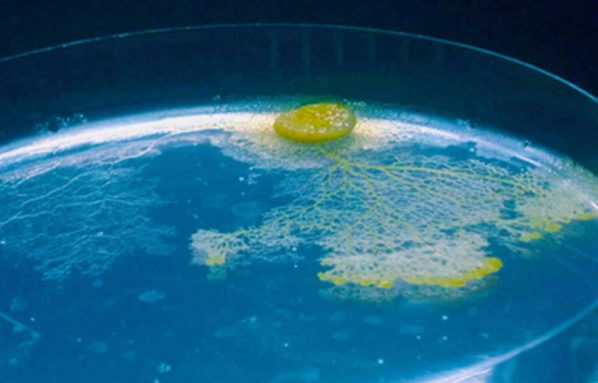A slime with memory
Even without a brain, this slime mold knows where it’s been

A slime mold called Physarum polycephalum is a throbbing, bright yellow blob that can crawl from one spot to another. Some people liken its appearance to moving, pulsing dog barf. Others clearly feel more tenderness toward the organism — enough to spend much of their life studying it. One such team of scientists now reports finding that although slime molds lack a brain, this goo may still have a memory of sorts.
Despite its name, a slime mold is not a mold or fungi. Although it moves, it’s not really an animal either. “A slime mold is just a little bag of goo,” explains biologist Chris R. Reid of the University of Sydney.
His team’s new research shows that a slime mold can tell where it’s been and usually avoids traveling on its own previous paths.
When this organism moves, it leaves behind trails of slime. These blobs appear to use those trails like memories, Reid says, and the ooze won’t revisit a previous path — if it has a choice.
Reid and his fellow scientists studied slime molds by putting them in simple tracks and mazes. In one experiment, when the researchers tricked 24 separate slime molds into going down a dead end, 23 of them escaped and found a route to a sugary treat.
A P. polycephalum slime mold has only one cell. Most such single-celled organisms are far too small to be seen by the naked eye. And most have only one nucleus, the part of its body that calls the shots. But slime molds aren’t like those other, ordinary one-celled organisms. They can grow as large as, well, dog barf, and contain a thousand or more nuclei. (In fact, polycephalum means many-headed.) As P. polycephalum engulfs stuff that gets in its way, it grows bigger without forming new cells, but generates more nuclei. The result is an organism called a plasmodium.
“It’s alien stuff,” Reid told Science News.
Other recent studies have demonstrated the many talents of the goo. In a maze, a slime mold can trace the shortest path through. And scientists have used food to entice a slime mold to build patterns that resemble maps of real highways or subway lines.
No scientists, however, have successfully taught a slime mold to catch, roll over or play dead. At least, not yet.
Power Words
slime mold A simple organism that consists of a single cell of creeping, jellylike protoplasm containing nuclei. It is not a mold, despite its name, and it isn’t even closely related to fungi.
cell The smallest structural and functional unit of an organism, typically microscopic and consisting of cytoplasm and a nucleus enclosed in a membrane. The cell of a slime mold, however, is easily visible to the naked eye and contains many nuclei.
nucleus A dense structure present in many cells. Typically a single rounded structure bounded by a double membrane, the nucleus contains the genetic information within a cell.
plasmodium A form within the life cycle of some simple organisms such as slime molds, typically consisting of a mass of naked protoplasm containing many nuclei.
protoplasm The colorless material comprising the living part of a cell, including the cytoplasm, nucleus and other structures.







